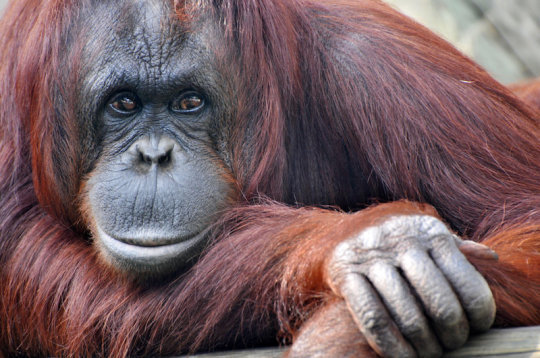Knuckle study might shed light on whether ancient humans walked or swung from trees

Orangutan (stock image)// © Glenda Powers / Adobe Stock
Depending on what their bones show. From ScienceDaily:
The study compared the internal bone structure of the knuckle joints in chimpanzee, bonobo, orangutan and gorilla hands, to assess whether this bone structure records how these apes moved when knuckle-walking on the ground or hanging from trees.
The researchers found the knuckle joints of orang-utans were consistent with flexing the knuckles while grasping branches, while the joints of chimpanzees, bonobos and gorillas were consistent with knuckle-walking — the most frequent ways in which these animals move around in their respective environments.
The information will now enable scientists studying fossils to better understand whether ancient humans were swinging from trees or walking on the ground.
Mr Dunmore said: “For the first time we see interesting internal bone patterns differentiating subtle differences between chimpanzee and gorilla knuckle-walking, as well as arboreal grasping in orang-utans. This matters because when we find ancient human hand fossils that preserve their internal structure, we can work out if they were probably swinging from trees during their lifetime or if they were walking on the ground more like humans today.”Paper. (paywall) – Christopher J. Dunmore, Tracy L. Kivell, Ameline Bardo, Matthew M. Skinner. Metacarpal trabecular bone varies with distinct hand positions used in hominid locomotion. Journal of Anatomy, 2019; DOI: 10.1111/joa.12966 More.
They might be onto something. After all, they are looking at a restricted type of evidence that may be abundant enough to enable a reasonable decision about some fossils. A far cry from the hype we so often hear.
Knuckle-walking:
More human hand theories: Human hand more primitive than chimp’s hand
Is The Non-Dominant Hand Vital To The Evolution Of The Thumb?
Latest evo theory features shoulder, not hand
Similarly, the human hand is simply a byproduct of changes to the shape of our feet. Or maybe not.Did stone tools really change human hands? Darwin speculated on this, which makes the idea canonical today. Curiously, while many claim that apes use and shape tools like humans, few speculate why doing so had no such dramatic effect on their hands.
We are told by others that fighting “may have” shaped the evolution of the human hand. One academic offers, “I think there is a lot of resistance, maybe more so among academics than people in general — resistance to the idea that, at some level humans are by nature aggressive animals.” Resistance? Really? Among academics and pundits, that is surely the conventional view!
Follow UD News at Twitter!
Copyright © 2019 Uncommon Descent . This Feed is for personal non-commercial use only. If you are not reading this material in your news aggregator, the site you are looking at is guilty of copyright infringement UNLESS EXPLICIT PERMISSION OTHERWISE HAS BEEN GIVEN. Please contact legal@uncommondescent.com so we can take legal action immediately.
Plugin by Taragana
Michael J. Behe's Blog
- Michael J. Behe's profile
- 219 followers



